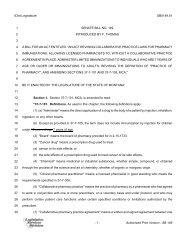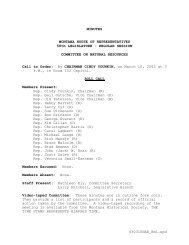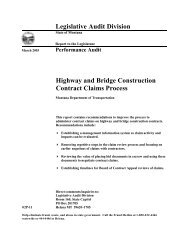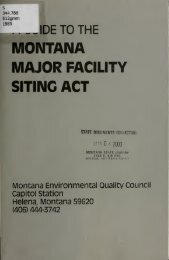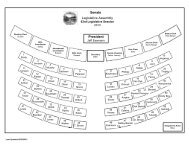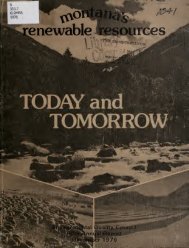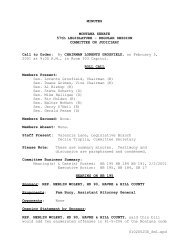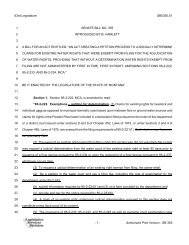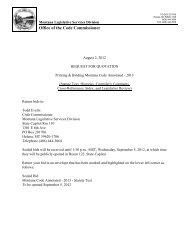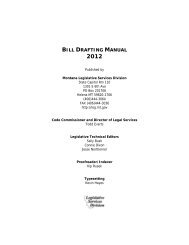Public Comment. Volume III - Montana Legislature
Public Comment. Volume III - Montana Legislature
Public Comment. Volume III - Montana Legislature
You also want an ePaper? Increase the reach of your titles
YUMPU automatically turns print PDFs into web optimized ePapers that Google loves.
Schoro v. Anaconda Co., 187 Mont. 377,385,6 10 P.2d 132, 136-7 (1 980). citing <strong>Montana</strong> Power<br />
Co. v. Bokrna, 153 Mont. 390,398,457 P.2d 769,774 (1 969); State Highway Comm 'n v. Yost Farm<br />
Co., 142 Mont. 239, 384 P.2d 277 (1963); Butte, A. & P. Ry. Co. v. <strong>Montana</strong> U Ry. Co., 16 Mont.<br />
504,4 1 P. 232 (1 895). See also State ex rel. Livingston v. District Court, 90 Mont. 19 1, 196, 300<br />
P. 916,918 (1931).<br />
When the plaintiff [MDT] selected its route, it did not lie in the mouth of the<br />
defendant to say that another possible route could have been selected. The plaintiff had<br />
the right to select a particular route which it deemed most advantageous.<br />
State v. Whitcomb, 94 Mont. 415,429,22 P.2d 823, 826 (1933).<br />
When the Highway Commission exercised its discretion and proposed to bypass<br />
Harlem, it became incumbent upon the defendant to show hud, abuse of discretion, or<br />
arbitrary action in order to defeat the action of the Commission. Whereas it was only<br />
necessary for the Highway Commission to establish that the taking of the property of<br />
Crossen-Nissen was reasonably necessary for the rebuilding of U.S. Highway No. 2 in<br />
order to be free from interference by the courts.<br />
... p]n regard to selecting the particular land to be condemned, it is the view of this<br />
court that even when necessity has been challenged on the ground of arbitrariness or<br />
excessiveness of the taking, there is left largely to the discretion of the condemnor the<br />
location, route and area of the land to be taken. There rests upon the shoulders of one<br />
seeking to show that the taking has been excessive or arbitrary, a heavy burden of proof<br />
in the attempt to persuade the court to substitute its judgment for that of the condemnor.<br />
(Nichols, Eminent Domain, 5 4.1 1(2), p. 558 (3d ed.))<br />
State Highway Comm 'n v. Crossen-Nissen, 145 Mont. 25 1,255,400 P.2d 283,285 (1965).<br />
plhe adoption of aresolution by the State Highway Commission declaring that a project<br />
is necessary to an authorized use and compatible with the greatest public good and least<br />
private harm creates a disputable presumption of the same. R.C.M. 1947,s 32-1 6 15<br />
[now Mont. Code Ann. 5 60-4-104(3)]. This presumption is overcome when the<br />
defendant property owners show bud, abuse of discretion, or arbitrary action. This<br />
requires clear and convincing proof.<br />
State Highway Comm 'n v. Danieben, 146 Mont. 539, 544,409 P.2d 443,445 (1965).<br />
Nonetheless, private injury is but one of the considerations present in a condemnation. ...<br />
Avoidance of increased costs as an element of the public good has been recognized by the<br />
Court .... Given these economic and ecological factors, we cannot find clear and<br />
convincing proof that the Highway Commission abused its discretion or acted arbitrarily.<br />
-1 14- <strong>Volume</strong> Ill: <strong>Public</strong> <strong>Comment</strong>



